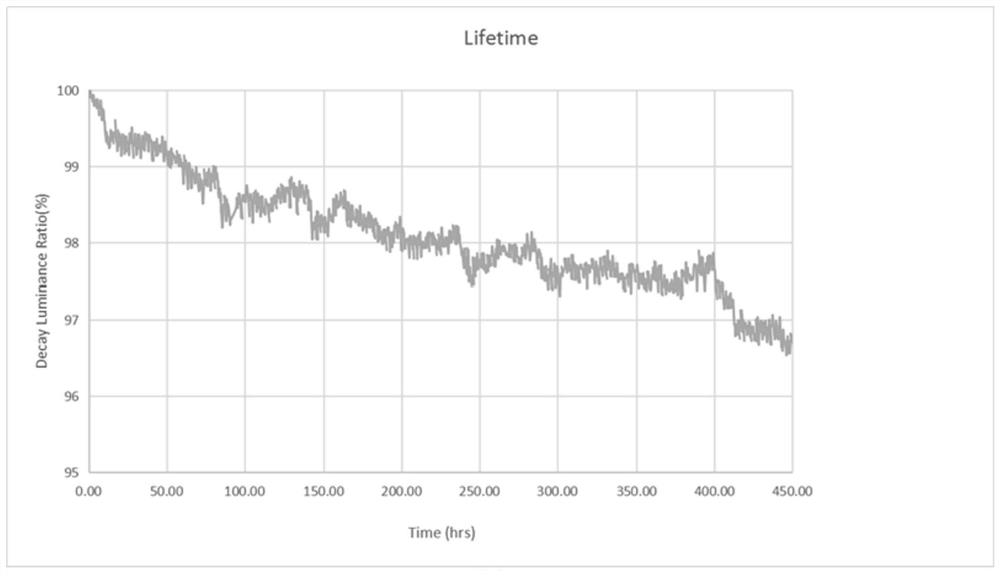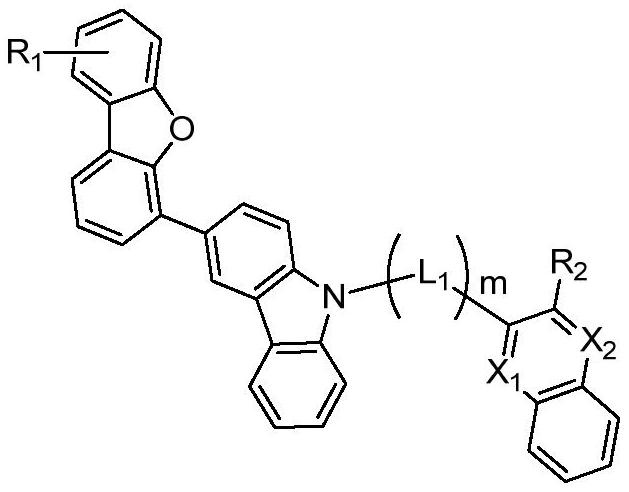A green phosphorescent host material and an OLED light-emitting device containing the material
A technology of host materials and light-emitting devices, applied in the direction of light-emitting materials, electric solid devices, semiconductor devices, etc., can solve the problems of unfavorable mass production of high-efficiency OLED devices, quenching device efficiency, high price, etc., and achieve an increase in glass transition temperature and thermal stability, improve stability and service life, reduce planarity and crystallinity
- Summary
- Abstract
- Description
- Claims
- Application Information
AI Technical Summary
Problems solved by technology
Method used
Image
Examples
Embodiment 1
[0042]
[0043] The synthesis method of green phosphorescence host material (1) comprises the following steps:
(1)
[0044]
[0045] Compound 1 ((Z)-N'-hydroxy-N-(pyridin-2-yl)carbamimidic chloride) (10g, 171g / mol, 1eq, 58.48mmol) was added to anhydrous THF (100g, the mass of compound 1 10 times), the temperature was lowered to 0°C under the protection of nitrogen, and trifluoroacetic anhydride (1.1eq, 210g / mol, 64.33mmol, 13.51g) was added dropwise and continued to stir for 30min, then slowly returned to room temperature, and continued to react for 3h. saturated NaHCO 3 (150g, 15 times the mass of compound 1) solution quenched, then extracted with methyl tert-butyl ether (150g, 15 times the mass of compound 1), dried over anhydrous sodium sulfate after separation, concentrated under reduced pressure and then column chromatography Purified to obtain compound 2 (2-chloro-[1,2,4]triazolo[1,5-a]pyridine) (6.82g, yield 76.2%), MS (EI): 153 (M + ).
(2)
[0046]
[0...
Embodiment 2
[0057]
[0058] The synthesis method of green phosphorescence host material (2) comprises the following steps:
[0059] Steps 1-4 are the same as in Example 1, and the steps are as follows:
(5)
[0060]
[0061] Compound 7 ((9-([1,2,4]triazolo[1,5-a]pyridin-2-yl)dibenzo[b,d]furan-4-yl)boronic acid) (5g, 329g / mol , 15.19mmol), compound 9 (9-(3-([1,1'-biphenyl]-3-yl)quinoxalin-2-yl)-3-bromo-9H-carbazole) (1eq, 7.97g, 525g / mol, 15.19mmol) and sodium carbonate (2eq, 3.22g, 105.99g / mol, 30.38mmol) were added to ethylene glycol diamine ether (100g, 20 times the mass of compound 7) and water (100g, 20 times the mass of compound 7 mass), stir and mix and then add three (o-tolyl) phosphine (3%eq, 0.14g, 304.37g / mol, 0.46mmol) and palladium (II) acetate (0.5%eq, 0.017g, 224.51g / mol, 0.075mmol), after heating up to reflux for 15h, the organic phase was separated, washed with water, concentrated under reduced pressure, and then subjected to column chromatography to obtain the ...
Embodiment 3
[0063]
[0064] The synthesis method of green phosphorescence host material (4) comprises the following steps:
[0065] Steps 1-4 are the same as in Example 1, and the steps are as follows:
(5)
[0066]
[0067] Compound 7 ((9-([1,2,4]triazolo[1,5-a]pyridin-2-yl)dibenzo[b,d]furan-4-yl)boronic acid) (5g, 329g / mol , 15.19mmol), Compound 10 (9-(3-([1,1'-biphenyl]-4-yl)quinoxalin-2-yl)-3-bromo-9H-carbazole) (1eq, 7.97g, 525g / mol, 15.19mmol) and sodium carbonate (2eq, 3.22g, 105.99g / mol, 30.38mmol) were added to ethylene glycol diamine ether (100g, 20 times the mass of compound 7) and water (100g, 20 times the mass of compound 7 mass), stir and mix and then add three (o-tolyl) phosphine (3%eq, 0.14g, 304.37g / mol, 0.46mmol) and palladium (II) acetate (0.5%eq, 0.017g, 224.51g / mol, 0.075mmol), after heating up to reflux for 15h, the organic phase was separated, washed with water, concentrated under reduced pressure, and then subjected to column chromatography to obtain the...
PUM
| Property | Measurement | Unit |
|---|---|---|
| thickness | aaaaa | aaaaa |
| thickness | aaaaa | aaaaa |
Abstract
Description
Claims
Application Information
 Login to View More
Login to View More - R&D
- Intellectual Property
- Life Sciences
- Materials
- Tech Scout
- Unparalleled Data Quality
- Higher Quality Content
- 60% Fewer Hallucinations
Browse by: Latest US Patents, China's latest patents, Technical Efficacy Thesaurus, Application Domain, Technology Topic, Popular Technical Reports.
© 2025 PatSnap. All rights reserved.Legal|Privacy policy|Modern Slavery Act Transparency Statement|Sitemap|About US| Contact US: help@patsnap.com



